《西方经济学》课程PPT教学课件(微观经济学)Chapter 01 Preliminaries
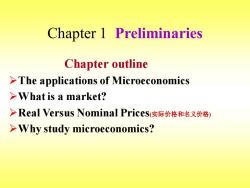
Chapter 1 Preliminaries Chapter outline >The applications of Microeconomics >What is a market? >Real Versus Nominal Prices(实际价格和名义价格) >Why study microeconomics?
Chapter 1 Preliminaries Chapter outline ➢The applications of Microeconomics ➢What is a market? ➢Real Versus Nominal Prices(实际价格和名义价格) ➢Why study microeconomics?

Microeconomics is concerned with the decisions made by small economic units-consumers,workers,investors,owners of resources,and business firms. It is also concerned with the interaction of consumers and firms to form markets and industries
❑ Microeconomics is concerned with the decisions made by small economic units-consumers, workers, investors, owners of resources, and business firms. It is also concerned with the interaction of consumers and firms to form markets and industries
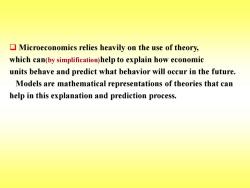
Microeconomics relies heavily on the use of theory, which can(by simplification)help to explain how economic units behave and predict what behavior will occur in the future. Models are mathematical representations of theories that can help in this explanation and prediction process
❑ Microeconomics relies heavily on the use of theory, which can(by simplification)help to explain how economic units behave and predict what behavior will occur in the future. Models are mathematical representations of theories that can help in this explanation and prediction process
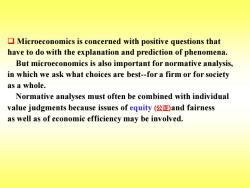
Microeconomics is concerned with positive questions that have to do with the explanation and prediction of phenomena. But microeconomics is also important for normative analysis, in which we ask what choices are best-for a firm or for society as a whole. Normative analyses must often be combined with individual value judgments because issues of equity (E)and fairness as well as of economic efficiency may be involved
❑ Microeconomics is concerned with positive questions that have to do with the explanation and prediction of phenomena. But microeconomics is also important for normative analysis, in which we ask what choices are best-for a firm or for society as a whole. Normative analyses must often be combined with individual value judgments because issues of equity (公正)and fairness as well as of economic efficiency may be involved
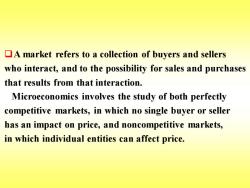
A market refers to a collection of buyers and sellers who interact,and to the possibility for sales and purchases that results from that interaction. Microeconomics involves the study of both perfectly competitive markets,in which no single buyer or seller has an impact on price,and noncompetitive markets, in which individual entities can affect price
❑A market refers to a collection of buyers and sellers who interact, and to the possibility for sales and purchases that results from that interaction. Microeconomics involves the study of both perfectly competitive markets, in which no single buyer or seller has an impact on price, and noncompetitive markets, in which individual entities can affect price
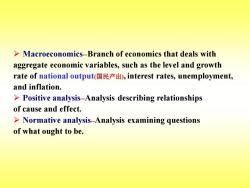
>Macroeconomics-Branch of economics that deals with aggregate economic variables,such as the level and growth rate of national output国民产出),interest rates,.unemployment, and inflation. >Positive analysis-Analysis describing relationships of cause and effect. Normative analysis-Analysis examining questions of what ought to be
➢ Macroeconomics-Branch of economics that deals with aggregate economic variables, such as the level and growth rate of national output(国民产出), interest rates, unemployment, and inflation. ➢ Positive analysis-Analysis describing relationships of cause and effect. ➢ Normative analysis-Analysis examining questions of what ought to be
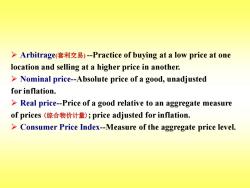
>Arbitrage(套利交易)-Practice of buying at a low price at one location and selling at a higher price in another. Nominal price-Absolute price of a good,unadjusted for inflation. >Real price-Price of a good relative to an aggregate measure of prices(综合物价计量);price adjusted for inflation. >Consumer Price Index-Measure of the aggregate price level
➢ Arbitrage(套利交易) -Practice of buying at a low price at one location and selling at a higher price in another. ➢ Nominal price-Absolute price of a good, unadjusted for inflation. ➢ Real price-Price of a good relative to an aggregate measure of prices (综合物价计量);price adjusted for inflation. ➢ Consumer Price Index-Measure of the aggregate price level
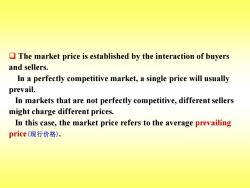
The market price is established by the interaction of buyers and sellers. In a perfectly competitive market,a single price will usually prevail. In markets that are not perfectly competitive,different sellers might charge different prices. In this case,the market price refers to the average prevailing price(现行价格)
❑ The market price is established by the interaction of buyers and sellers. In a perfectly competitive market, a single price will usually prevail. In markets that are not perfectly competitive, different sellers might charge different prices. In this case, the market price refers to the average prevailing price(现行价格)
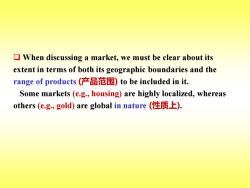
When discussing a market,we must be clear about its extent in terms of both its geographic boundaries and the range of products(产品范围)to be included in it. Some markets (e.g.,housing)are highly localized,whereas others(e.g.,gold)are global in nature(性质上)
❑ When discussing a market, we must be clear about its extent in terms of both its geographic boundaries and the range of products (产品范围) to be included in it. Some markets (e.g., housing) are highly localized, whereas others (e.g., gold) are global in nature (性质上)
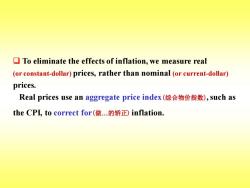
To eliminate the effects of inflation,we measure real (or constant-dollar)prices,rather than nominal (or current-dollar) prices. Real prices use an aggregate price index(综合物价指数),such as the CPI,to correct for(做.的矫正)inflation
❑ To eliminate the effects of inflation, we measure real (or constant-dollar) prices, rather than nominal (or current-dollar) prices. Real prices use an aggregate price index(综合物价指数),such as the CPI, to correct for(做.的矫正) inflation
按次数下载不扣除下载券;
注册用户24小时内重复下载只扣除一次;
顺序:VIP每日次数-->可用次数-->下载券;
- 《西方经济学》课程PPT教学课件(宏观经济学)Chapter 19 Advances in Business Cycle theory.ppt
- 《西方经济学》课程PPT教学课件(宏观经济学)Chapter 17 Investment.ppt
- 《西方经济学》课程PPT教学课件(宏观经济学)Chapter 18 Money supply and monetary Policy.ppt
- 《西方经济学》课程PPT教学课件(宏观经济学)Chapter 16 Consumption.ppt
- 《西方经济学》课程PPT教学课件(宏观经济学)Chapter 15Government Debt and Budget Deficits.ppt
- 《西方经济学》课程PPT教学课件(宏观经济学)Chapter 14 Stabilization Policy.ppt
- 《西方经济学》课程PPT教学课件(宏观经济学)Chapter 13 Aggregate supply.ppt
- 《西方经济学》课程PPT教学课件(宏观经济学)Chapter 12 Aggregate demand in open economy.ppt
- 《西方经济学》课程PPT教学课件(宏观经济学)Chapter 11 Application of IS-LM model.ppt
- 《西方经济学》课程PPT教学课件(宏观经济学)Chapter 10 The IS-LM model.ppt
- 《西方经济学》课程PPT教学课件(宏观经济学)Chapter 09 Introduction to AS-AD model.ppt
- 《西方经济学》课程PPT教学课件(宏观经济学)Chapter 07 Economic growth(1/2).ppt
- 《西方经济学》课程PPT教学课件(宏观经济学)Chapter 08 Economic growth(2/2).ppt
- 《西方经济学》课程PPT教学课件(宏观经济学)Chapter 06 Unemployment.ppt
- 《西方经济学》课程PPT教学课件(宏观经济学)Chapter 05 The open economy.ppt
- 《西方经济学》课程PPT教学课件(宏观经济学)Chapter 04 Money and inflation.ppt
- 《西方经济学》课程PPT教学课件(宏观经济学)Chapter 03 Where NI comes from and goes.ppt
- 《西方经济学》课程PPT教学课件(宏观经济学)Chapter 02 The Data of Macroeconomics.ppt
- 《西方经济学》课程PPT教学课件(宏观经济学)Chapter 01 The Science of Macroeconomics.ppt
- 海南大学:《西方经济学》课程试卷解答(微观经济学)2009-2010微观经济学(A)试卷.doc
- 《西方经济学》课程PPT教学课件(微观经济学)Chapter 02 The Basics of Supply and Demand.ppt
- 《西方经济学》课程PPT教学课件(微观经济学)Chapter 03 Consumer Behavior.ppt
- 《西方经济学》课程PPT教学课件(微观经济学)Chapter 04 Individual and Market Demand.ppt
- 《西方经济学》课程PPT教学课件(微观经济学)Chapter 05 Choice under Uncertainty.ppt
- 《西方经济学》课程PPT教学课件(微观经济学)Chapter 06 Production.ppt
- 《西方经济学》课程PPT教学课件(微观经济学)Chapter 07 The Cost of Production.ppt
- 《西方经济学》课程PPT教学课件(微观经济学)Chapter 08 Profit Maximization and Competitive Supply.ppt
- 《西方经济学》课程PPT教学课件(微观经济学)Chapter 09 The Analysis of Competitive Markets.ppt
- 《西方经济学》课程PPT教学课件(微观经济学)Chapter 10 Market Power.ppt
- 《西方经济学》课程PPT教学课件(微观经济学)Chapter 11 Pricing with Market Power.ppt
- 《西方经济学》课程PPT教学课件(微观经济学)Chapter 12 Monopolistic Competition.ppt
- 《西方经济学》课程PPT教学课件(微观经济学)Chapter 13 Game Theory.ppt
- 《西方经济学》课程PPT教学课件(微观经济学)Chapter 14 Markets for Factor Inputs.ppt
- 《西方经济学》课程PPT教学课件(微观经济学)Chapter 15 Investment, Time, and Capital.ppt
- 《西方经济学》课程PPT教学课件(微观经济学)Chapter 16 General Equilibrium and Economic Efficiency.ppt
- 《西方经济学》课程PPT教学课件(微观经济学)Chapter 17 Markets with Asymmetric Information.ppt
- 《西方经济学》课程PPT教学课件(微观经济学)Chapter 18 Externalities.ppt
- 《西方经济学》课程PPT教学课件(微观经济学)Chapter 17 Microeconomics.ppt
- 海南大学:《成本会计》课程课程教学大纲 COST ACCOUNTING.pdf
- 海南大学:《成本会计》课程教学资源(教案讲义)第一章 总论.doc
